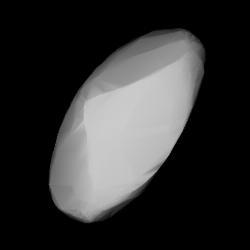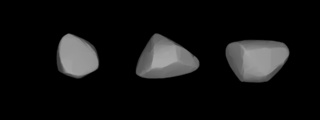Related Research Articles
113390 Helvetia (provisional designation 2002 SU19) is a background asteroid from the inner regions of the asteroid belt, approximately 2.2 kilometers (1.4 miles) kilometers in diameter. It was discovered on 29 September 2002, by Swiss astronomer Markus Griesser at the Eschenberg Observatory in Winterthur, near Zürich, Switzerland. The presumed stony Florian asteroid was named after the Swiss national symbol, Helvetia.
Pawlowia, provisional designation 1923 OX, is a background asteroid from the central regions of the asteroid belt, approximately 20 kilometers in diameter. It was discovered on 5 October 1923, by Soviet astronomer Vladimir Albitsky at the Simeiz Observatory on the Crimean peninsula. The asteroid was named after Russian physiologist and Nobelist Ivan Pavlov.
1141 Bohmia, provisional designation 1930 AA, is a Florian asteroid from the inner regions of the asteroid belt, approximately 6 kilometers in diameter. It was discovered by German astronomer Max Wolf at the Heidelberg-Königstuhl State Observatory on 4 January 1930. The asteroid was named after German philanthropist Katharina Bohm-Waltz.
2006 Polonskaya (provisional designation: 1973 SB3) is a stony Flora asteroid and asynchronous binary system from the inner regions of the asteroid belt, approximately 5 kilometers (3.1 miles) in diameter. It was discovered on 22 September 1973, by Soviet astronomer Nikolai Chernykh at the Crimean Astrophysical Observatory in Nauchnij, on the Crimean peninsula, and later named after Ukrainian astronomer Elena Kazimirtchak-Polonskaïa. Its one-kilometer-sized satellite was discovered by an international collaboration of astronomers in November 2005.
1047 Geisha, provisional designation 1924 TE, is a stony Florian asteroid from the inner regions of the asteroid belt, approximately 11 kilometers in diameter. It was discovered on 17 November 1924, by German astronomer Karl Reinmuth at the Heidelberg-Königstuhl State Observatory in southwest Germany. The asteroid was named after the British musical The Geisha.
6235 Burney, provisional designation 1987 VB, is a Florian or background asteroid from the inner regions of the asteroid belt, approximately 4 kilometers in diameter. It was discovered on 14 November 1987, by Japanese astronomers Seiji Ueda and Hiroshi Kaneda at the Kushiro Observatory on Hokkaido, Japan. The likely elongated L-type asteroid has a rotation period of 15.5 hours. It was named for Venetia Burney, who first proposed Pluto's name.
1120 Cannonia, provisional designation 1928 RV, is a stony Florian asteroid from the inner regions of the asteroid belt, approximately 10 kilometers in diameter. Discovered by Pelageya Shajn at Simeiz in 1928, it was named after American astronomer Annie Jump Cannon.

2839 Annette is a bright Flora asteroid from the inner regions of the asteroid belt. It was discovered on 5 October 1929, by American astronomer Clyde Tombaugh at Lowell Observatory during his search for Pluto. The presumed S-type asteroid has a rotation period of 10.5 hours and measures approximately 5 kilometers in diameter. It was named after the discoverer's daughter.
1252 Celestia, provisional designation 1933 DG, is a stony asteroid located in the central asteroid belt. It was discovered on 19 February 1933, by astronomer Fred Whipple at the Oak Ridge Observatory operated by the Harvard-Smithsonian Center for Astrophysics in Massachusetts, United States. The S-type asteroid has a rotation period of 10.6 hours and measures approximately 20 kilometers in diameter. It was named after the discoverer's mother, Celestia MacFarland Whipple.
1707 Chantal, provisional designation 1932 RL, is a stony background asteroid from the Florian region in the inner asteroid belt, approximately 7.5 kilometers in diameter. It was discovered on 8 September 1932, by astronomer Eugène Delporte at the Royal Observatory of Belgium in Uccle. The S-type asteroid has a rotation period of at least 10 hours. It was named for Chantal, the niece of Belgian astronomer Georges Roland.
2571 Geisei, provisional designation 1981 UC, is a stony Florian asteroid from the inner regions of the asteroid belt, approximately 6 kilometers in diameter. It was discovered by Japanese astronomer Tsutomu Seki at Geisei Observatory on 23 October 1981, and named for the Japanese village of Geisei.
2324 Janice, provisional designation 1978 VS4, is a dark background asteroid from the outer regions of the asteroid belt, approximately 25 kilometers (16 miles) in diameter. It was discovered on 7 November 1978, by American astronomers Eleanor Helin and Schelte Bus at the Palomar Observatory in California. The asteroid was named for Janice Cline at Caltech. The presumably C-type asteroid has a rotation period of 23.2 hours.
9223 Leifandersson, provisional designation 1995 YY7, is a background asteroid from the inner regions of the asteroid belt, approximately 4.5 kilometers in diameter. It was discovered on 18 December 1995, by astronomers of the Spacewatch program at Kitt Peak National Observatory in Arizona, United States. The asteroid was named in memory of Swedish astronomer Leif Erland Andersson. The assumed stony asteroid has a rotation period of 3.758 hours.
1455 Mitchella, provisional designation 1937 LF, is a Florian asteroid, slow rotator and suspected tumbler from the inner regions of the asteroid belt, approximately 7 kilometers in diameter. It was discovered on 5 June 1937, by astronomer Alfred Bohrmann at the Heidelberg-Königstuhl State Observatory in southwest Germany. The asteroid was named after American astronomer Maria Mitchell.
2648 Owa, provisional designation 1980 VJ, is a background asteroid from the Flora region of the inner asteroid belt, approximately 6 kilometers in diameter. It was discovered on 8 November 1980, by American astronomer Edward Bowell at the Anderson Mesa Station near Flagstaff, Arizona, in the United States. The presumably S-type asteroid has a rotation period of 3.56 hours. It was named for the word "rock" in the Native American Hopi language.
1990 Pilcher, provisional designation 1956 EE, is a stony background asteroid from the Florian region of the inner asteroid belt, approximately 7 kilometers in diameter. It was discovered on 9 March 1956, by German astronomer Karl Reinmuth at the Heidelberg-Königstuhl State Observatory in Heidelberg, Germany. In 1982, it was named by the MPC for American physicist and photometrist Frederick Pilcher. The S-type asteroid has a short rotation period of 2.8 hours.

1518 Rovaniemi, provisional designation 1938 UA, is a stony Florian asteroid from the inner regions of the asteroid belt, approximately 8 kilometers in diameter. Discovered by Yrjö Väisälä at the Turku Observatory in 1938, the asteroid was later named after the Finnish city of Rovaniemi.
13260 Sabadell, prov. designation: 1998 QZ15, is a stony Eunomia asteroid from the central region of the asteroid belt. It was discovered by Catalan amateur astronomers Ferran Casarramona and Antoni Vidal at the Montjoia Observatory (953), Barcelona, on 23 August 1998. The likely elongated asteroid measures approximately 5.3 kilometers (3.3 miles) in diameter and has a rotation period of 5.3 hours. It was named after the astronomical society "Agrupació Astronòmica de Sabadell".
2554 Skiff, provisional designation 1980 OB, is a Florian asteroid from the inner regions of the asteroid belt, approximately 7 kilometers in diameter. It was discovered on 17 July 1980, by American astronomer Edward Bowell at Lowell's Anderson Mesa Station near Flagstaff, Arizona. The presumed S-type asteroid has a rotation period of 25.6 hours and was named after astronomer Brian Skiff.
23327 Luchernandez (provisional designation 2001 BE31) is a Florian asteroid from the inner regions of the asteroid belt, approximately 2 kilometers in diameter. It was discovered on 20 January 2001, by astronomers of the LINEAR program at the Lincoln Laboratory's Experimental Test Site near Socorro, New Mexico, United States. The asteroid was named for ISEF awardee Lucero Hernandez.
References
- 1 2 3 4 "4362 Carlisle (1978 PR4)". Minor Planet Center. Retrieved 30 August 2021.
- 1 2 3 Schmadel, Lutz D. (2007). "(4362) Carlisle". Dictionary of Minor Planet Names. Springer Berlin Heidelberg. p. 374. doi:10.1007/978-3-540-29925-7_4313. ISBN 978-3-540-00238-3.
- 1 2 "Asteroid 4362 Carlisle". Small Bodies Data Ferret. Retrieved 30 August 2021.
- 1 2 Zappalà, V.; Bendjoya, Ph.; Cellino, A.; Farinella, P.; Froeschle, C. (1997). "Asteroid Dynamical Families". NASA Planetary Data System: EAR-A-5-DDR-FAMILY-V4.1. Retrieved 30 August 2021.} (PDS main page)
- 1 2 3 "JPL Small-Body Database Browser: 4362 Carlisle (1978 PR4)" (2021-08-09 last obs.). Jet Propulsion Laboratory . Retrieved 30 August 2021.
- 1 2 3 4 5 6 7 Johnston, Wm. Robert (12 July 2021). "Asteroids with Satellites Database – (4362) Carlisle". Johnston's Archive. Retrieved 30 August 2021.
- 1 2 3 Masiero, Joseph R.; Mainzer, A. K.; Grav, T.; Bauer, J. M.; Cutri, R. M.; Nugent, C.; et al. (November 2012). "Preliminary Analysis of WISE/NEOWISE 3-Band Cryogenic and Post-cryogenic Observations of Main Belt Asteroids". The Astrophysical Journal Letters. 759 (1): 5. arXiv: 1209.5794 . Bibcode:2012ApJ...759L...8M. doi:10.1088/2041-8205/759/1/L8 . Retrieved 24 May 2016.
- 1 2 3 Masiero, Joseph R.; Mainzer, A. K.; Grav, T.; Bauer, J. M.; Cutri, R. M.; Dailey, J.; et al. (November 2011). "Main Belt Asteroids with WISE/NEOWISE. I. Preliminary Albedos and Diameters". The Astrophysical Journal. 741 (2): 20. arXiv: 1109.4096 . Bibcode:2011ApJ...741...68M. doi:10.1088/0004-637X/741/2/68 . Retrieved 5 December 2016.
- 1 2 3 Mainzer, A.; Grav, T.; Masiero, J.; Hand, E.; Bauer, J.; Tholen, D.; et al. (November 2011). "NEOWISE Studies of Spectrophotometrically Classified Asteroids: Preliminary Results". The Astrophysical Journal. 741 (2): 25. arXiv: 1109.6407 . Bibcode:2011ApJ...741...90M. doi:10.1088/0004-637X/741/2/90 . Retrieved 24 May 2016.
- 1 2 3 4 5 "LCDB Data for (4362) Carlisle". Asteroid Lightcurve Database (LCDB). Retrieved 30 August 2021.
- ↑ Nesvorný, D.; Broz, M.; Carruba, V. (December 2014). "Identification and Dynamical Properties of Asteroid Families". pp. 297–321. arXiv: 1502.01628 . Bibcode:2015aste.book..297N. doi:10.2458/azu_uapress_9780816532131-ch016. ISBN 978-0-8165-3213-1.
{{cite book}}:|journal=ignored (help); Missing or empty|title=(help) - ↑ "Asteroid 4362 Carlisle – Proper Elements". AstDyS-2, Asteroids – Dynamic Site. Retrieved 30 August 2021.
- ↑ "MPC/MPO/MPS Archive". Minor Planet Center. Retrieved 24 May 2016.
- 1 2 3 4 "(4362) Carlisle is a binary asteroid". Central Bureau Electronic Telegrams . Retrieved 30 August 2021.